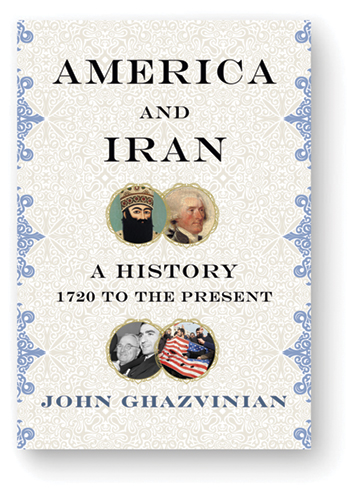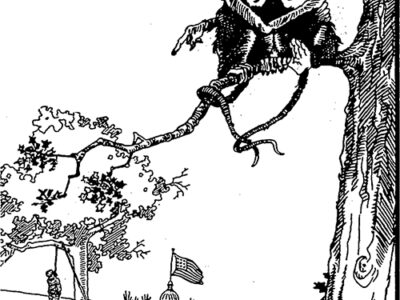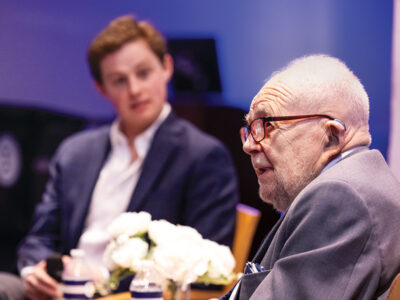
Before relations between the two countries became poisoned, America and Iran shared a long history of “mutual idealization.”
Images of rioters scaling a wall of the US Capitol on January 6 reminded John Ghazvinian, executive director of Penn’s Middle East Center, of another famous scene, from his native Iran. On Twitter he posted a photograph of the recent incursion alongside another of Iranian students breaching the US Embassy in Tehran in 1979.
That attack, by supporters of Iran’s Islamic Revolution, inaugurated a 14-month hostage crisis that likely cost President Jimmy Carter a second term—and fixed Iran as a foe in the American psyche. Its immediate trigger was Carter’s decision to allow the ousted Shah of Iran into the United States for medical treatment. But anti-US sentiment also had historical roots, in the CIA’s role in a 1953 anti-democratic coup that deposed a popular prime minister and strengthened the shah.
Yet the relationship between the two countries hasn’t always been hostile, as Ghazvinian makes clear in his new book, America and Iran: A History, 1720 to the Present (Alfred A. Knopf). “This was the great surprise for me,” he says, “to realize that this is a story of two countries that, for the overwhelming majority of their history, have been very warm and affectionate towards each other—where the history is full of mutual admiration, mutual fascination, even a sort of mutual idealization.”
In his introduction, he writes: “The Iran hostage crisis of 1979 has become a kind of original sin—the moment the serpent slipped into the Garden of Eden and brought an end to the comfortable illusion of American global invincibility. The unforgivable has become the unforgiven. And nothing has been the same since.”
In 1950s Iran, after the CIA helped overthrow Prime Minister Mohammad Mosaddeq, “a generation that had adored America—a generation raised on years of John Wayne movies and big, stylish Chevrolets— … quickly grew to hate it,” Ghazvinian writes. “So it has remained, for forty years. History—like almost everything else—has become a casualty in the long-running war of words between Iran and the United States.”
Ghazvinian’s book aims to be a corrective. One of his epigraphs quotes the 14th-century Persian poet Hafez on “the lingering sorrow of separation,” a theme that infuses his narrative. The second epigraph is a 1986 statement from President Ronald Reagan that “between American and Iranian basic national interests there need be no permanent conflict.” Ghazvinian argues that, US fears notwithstanding, Iran has no real intention of building nuclear weapons, and the two countries could find common cause in regional stability and opposition to the Taliban, ISIS, and other Sunni jihadist groups.
Wondering “how things went so wrong” between the US and Iran, Ghazvinian discovered “the question we never ask, which is ‘How did things go right in the first place?’” After all, implicit in the assumption that “things have gone wrong is that things weren’t always so bad,” he says. “There’s a tendency to want to use history as a kind of blame game. That’s not what history should be about.”
The 46-year-old Ghazvinian dedicates America and Iran to his parents, “who lived too much of this history.” His father, a scientist and educator turned businessman, and his mother, a secretary and homemaker, left Iran in 1975, when their only child was just one. Ghazvinian calls their decision to emigrate “aspirational” and stresses that they were neither political nor economic refugees. “We had a good life,” he says. But the regime of Mohammad Reza Shah Pahlavi was tightening its repressive grip, and his father believed “this was not a country going in the right direction.”
The family settled in London, then Los Angeles, where Ghazvinian attended high school. After graduating from Brown University, he earned his doctorate in British history at the University of Oxford. In London, he worked as a stringer for Newsweek and other publications, and, in 2007, he published Untapped: The Scramble for Africa’s Oil (Harcourt), which Publishers Weekly praised for “bringing perspective to the chaos.”
Ghazvinian says that he had never intended to write about Iran. But after the 9/11 terrorist attacks, he felt “called upon,” to explain the Middle East, even though “a lot of us [from the region] don’t understand the Middle East ourselves either.”
It was helpful that he spoke Farsi, though not as fluently as his British-accented English. And as a dual US and Iranian citizen, he was able to travel freely to Iran (though, about a year ago, federal customs agents in New York pulled him aside and interrogated him about his political views). He managed to gain access to the Iranian Foreign Ministry archives, a rare—if not unique—coup for an American scholar, after “hours of pleading phone calls,” “political background checks,” “sudden rule changes,” and other impediments.
In US archives, he was surprised to see how extensively, and sympathetically, colonial newspapers covered Persia, as Iran was known until 1935. “It absolutely blew my mind,” he says, “to discover that the very first newspapers published in North America, in Boston in 1720, were obsessed with the big international news story of the day”—an Afghan uprising against the Persian Empire in reaction to forced conversions from Sunni to Shia Islam. American newspapers, he says, wrongly assumed that the Afghans were colluding with the Ottoman Empire, “the hated evil empire of its day.” By contrast, they regarded Persia as an “idyllic, fairy-tale land,” and the country’s Shia faith as “somehow less Muslim—and therefore less evil.”
In the 19th and early 20th centuries, the imperial powers of Britain and Russia wrestled for influence over Iran, “using bribes, economic leverage, and political intrigue to stage-manage the decisions of the Persian government,” Ghazvinian writes. To balance out those pressures, he says, “successive Iranian governments tried to cultivate the US as a sort of third force.”
Iran’s Constitutional Revolution created an elected parliament in 1906 to check the shah’s power. And, in 1911, the government invited an American lawyer, William Morgan Shuster, “every inch the can-do American trailblazer,” to become treasurer-general and straighten out the country’s tangled finances. Shuster, interpreting his mission broadly and taking on British and Russian interference, became an unlikely Iranian hero, an embodiment of nationalist aspirations and democratic ideals.
But the political hero who truly bestrides Ghazvinian’s narrative is Mosaddeq, an aristocrat who led the country’s liberal reformers. “He was as bald as a melon, walked with a cane, and suffered from a nervous condition that often manifested itself in the form of fainting spells,” Ghazvinian writes. “But he was also one of the most charismatic, free-spirited, and uncompromising figures of the twentieth century.”
Mosaddeq’s ouster, in 1953, consolidated the shah’s rule, which encompassed both secret police terror and modernizing reforms. Gaylord Harnwell Hon’53, a physicist who was Penn’s president from 1953 to 1970, helped the shah establish an American-style university in the city of Shiraz, an experience he chronicled in Educational Voyaging in Iran (University of Pennsylvania Press). In 1962, the year Harnwell’s book appeared, Penn awarded an honorary doctorate to the shah, who arrived for the ceremony via a helicopter landing in Franklin Field.
Another Penn-Iran connection was forged by archaeological digs, beginning in the 1930s, which helped the University amass a world-class collection of Persian antiquities. A 1958 photograph in America and Iran shows Penn anthropologist Robert H. Dyson Jr., later dean of the Faculty (now School) of Arts and Sciences and director of the Penn Museum, triumphantly displaying a golden bowl unearthed at the Iranian site of Hasanlu.
After World War II, US administrations tended to see Iran through the scrim of the Cold War. Fearing the shah’s demise could lead to Communist ascendancy, an assumption Ghazvinian disputes, they mostly overlooked the regime’s abuses. President Carter’s human-rights rhetoric seemed to challenge that posture and emboldened opposition forces. But Carter ultimately declined to break with longstanding American policy and traveled to Tehran in December 1977 to toast the shah’s country as “an island of stability”—a week before the outbreak of the Islamic Revolution.
Despite having “no special love for the Islamic Republic,” Ghazvinian argues that demonizing it is counterproductive. “You don’t have to like the Islamic Republic,” he says, “to recognize that it did come to power on the back of a massive popular revolution” nor “to recognize that a generation of young men gave their lives” to defend it in the savage 1980–88 war against Iraq.
Since the 1990s, the Islamic Republic has adopted a “more pragmatic and realistic foreign policy that has not always been met by pragmatism and realism on the American side,” he says. “And you don’t have to like the Islamic Republic to recognize that this [US] policy of brutal, extreme sanctions and maximum pressure is simply not going to achieve anything other than the suffering of the Iranian people.”
Ghazvinian is a proponent of the 2015 nuclear agreement, which imposed restrictions on Iran’s development of nuclear energy in exchange for sanctions relief. The Trump administration withdrew from the deal in 2018.
President Joe Biden faces “a real challenge” in improving relations, Ghazvinian says, given the limited window before June’s Iranian presidential election. In the wake of the US’s abrogation of the nuclear deal, he says, a more hardline candidate is likely to win.
Nevertheless, despite lingering distrust on both sides, Ghazvinian remains optimistic. The logic supporting a better relationship between the two nations “hasn’t really gone away,” he says. “There’s no reason why at some point these countries couldn’t lay aside their enmity and even become friends.”
—Julia M. Klein




